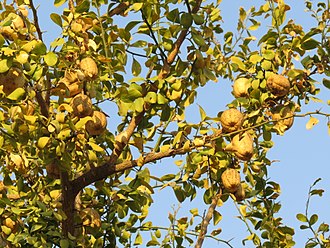Balanites aegyptiaca
Balanites aegyptiaca, commonly known as the Desert Date, is a species of tree in the Zygophyllaceae family, native to much of Africa and parts of the Middle East. It is a versatile and resilient species, adapted to survive in harsh desert and semi-desert environments. This article provides an overview of its characteristics, uses, and ecological significance.
Description
Balanites aegyptiaca is a spiny, evergreen tree that can grow up to 10 meters in height. Its branches are spread out and bear green leaves. The tree produces small, fragrant yellow flowers, which are followed by oval, yellowish-green fruits. The fruit contains a hard, woody stone that encloses one or two seeds. The tree's bark and roots are known for their distinctive, deeply fissured appearance.
Distribution and Habitat
Balanites aegyptiaca is widely distributed across the Sahel region of Africa, extending from Senegal in the west to Sudan and Ethiopia in the east. It is also found in parts of the Arabian Peninsula. The tree thrives in arid and semi-arid zones, where it is a key component of savannah and desert ecosystems. It prefers sandy and loamy soils and can tolerate drought, high temperatures, and poor soil conditions.
Uses
Balanites aegyptiaca has numerous traditional and commercial uses. Its fruit is edible and is often used in local cuisines. The seeds are rich in oil, which is used for cooking and in traditional medicine. The oil has also been explored for its potential in biodiesel production. The wood of the tree is hard and durable, making it suitable for construction and as fuel. Medicinally, various parts of the tree, including the bark, roots, and leaves, have been used to treat a range of ailments, from skin diseases to malaria and intestinal worms.
Ecological Significance
The Balanites aegyptiaca plays a crucial role in its ecosystem. It provides shade and shelter for wildlife and livestock, and its fruits are a source of food for many bird and animal species. The tree's deep root system helps to stabilize the soil and prevent erosion. Additionally, it is often used in agroforestry systems to improve soil fertility and support the growth of other crops.
Conservation
While Balanites aegyptiaca is not currently listed as endangered, its habitat is threatened by desertification, overgrazing, and land clearance for agriculture. Efforts to conserve the species include promoting its sustainable use and integrating it into reforestation and land rehabilitation projects.
Transform your life with W8MD's budget GLP-1 injections from $125.
W8MD offers a medical weight loss program to lose weight in Philadelphia. Our physician-supervised medical weight loss provides:
- Most insurances accepted or discounted self-pay rates. We will obtain insurance prior authorizations if needed.
- Generic GLP1 weight loss injections from $125 for the starting dose.
- Also offer prescription weight loss medications including Phentermine, Qsymia, Diethylpropion, Contrave etc.
NYC weight loss doctor appointments
Start your NYC weight loss journey today at our NYC medical weight loss and Philadelphia medical weight loss clinics.
- Call 718-946-5500 to lose weight in NYC or for medical weight loss in Philadelphia 215-676-2334.
- Tags:NYC medical weight loss, Philadelphia lose weight Zepbound NYC, Budget GLP1 weight loss injections, Wegovy Philadelphia, Wegovy NYC, Philadelphia medical weight loss, Brookly weight loss and Wegovy NYC
|
WikiMD's Wellness Encyclopedia |
| Let Food Be Thy Medicine Medicine Thy Food - Hippocrates |
Medical Disclaimer: WikiMD is not a substitute for professional medical advice. The information on WikiMD is provided as an information resource only, may be incorrect, outdated or misleading, and is not to be used or relied on for any diagnostic or treatment purposes. Please consult your health care provider before making any healthcare decisions or for guidance about a specific medical condition. WikiMD expressly disclaims responsibility, and shall have no liability, for any damages, loss, injury, or liability whatsoever suffered as a result of your reliance on the information contained in this site. By visiting this site you agree to the foregoing terms and conditions, which may from time to time be changed or supplemented by WikiMD. If you do not agree to the foregoing terms and conditions, you should not enter or use this site. See full disclaimer.
Credits:Most images are courtesy of Wikimedia commons, and templates, categories Wikipedia, licensed under CC BY SA or similar.
Contributors: Prab R. Tumpati, MD



